When you step into a garden, one of the first things you notice isn’t always the flowers in the center it’s the borders.
Green borders shape the way we move through an outdoor space, frame views, and add an enchanting sense of order and beauty.
Whether you want a formal look with clipped hedges or a whimsical cottage-style edge overflowing with blooms, borders hold the power to transform an ordinary yard into a magical retreat.
In this article, we’ll explore the secrets of Green Border Magic, from plant choices and textures to design tips that turn your garden edges into works of art.
🌱 Why Green Borders Matter
Borders are more than decorative frames they’re functional and transformative. Here’s why they’re a must-have in any outdoor design:
-
Define spaces: Borders outline walkways, patios, and flowerbeds, giving structure and flow.
-
Create layers: They provide depth and dimension, making a garden look full and balanced.
-
Support biodiversity: Borders filled with flowers and herbs attract pollinators and beneficial insects.
-
Year-round appeal: Evergreens and groundcovers ensure your garden stays alive even in winter.
-
Practicality: Borders prevent soil erosion, help with weed control, and soften harsh edges of stone or wood.
In short, they tie the garden together much like a frame completes a painting.
🌸 Ideas to Create Green Border Magic
1. Evergreen Elegance 🌲
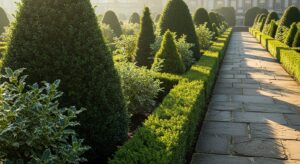
Evergreens like boxwood, holly, and dwarf conifers are the backbone of border design. They provide structure year-round, making your garden look polished even in the off-season.
Boxwoods can be trimmed into neat hedges for a formal look, while dwarf conifers bring a sculptural quality.
Pair them with perennials for seasonal pops of color against their deep green backdrop.
2. Flowering Borders for Seasonal Charm 🌼
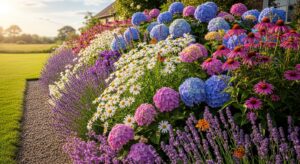
Flower borders bring life and vibrancy to any garden.
Try planting lavender, daisies, hydrangeas, and echinacea along walkways or patio edges. By mixing perennials with annuals, you can ensure your borders bloom in waves throughout the growing season.
Consider color palettes soft pastels for a romantic cottage vibe, or bold reds and yellows for an energetic, welcoming look.
3. Herb Borders with a Purpose 🌿🍃
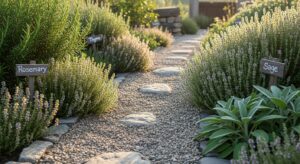
Why not let your borders be useful as well as beautiful? Herbs like rosemary, thyme, chives, and sage double as lush greenery and culinary treasures.
Their aromatic foliage adds a sensory layer to your garden, delighting you each time you pass by.
Plant creeping thyme along pathways so every step releases a gentle fragrance.
4. Grasses for Movement and Texture 🌾

Ornamental grasses are a secret weapon for creating magical borders.
Varieties like fountain grass, blue fescue, and feather reed grass sway in the breeze, adding motion and a soft, natural rhythm to your garden.
They contrast beautifully with flowering plants, breaking up rigid lines with flowing elegance. In autumn, their golden plumes bring seasonal warmth.
5. Low-Growing Groundcovers 🌿🌸
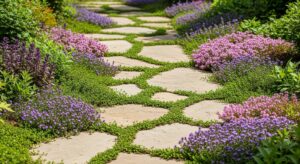
Groundcovers such as creeping thyme, ajuga, and sedum are perfect for filling gaps and softening stone edges.
They spread naturally, creating a lush green carpet that prevents weeds from sneaking in. Many also bloom in spring and summer, adding subtle color and texture right at the garden’s edge.
6. Mixed Borders for Visual Interest 🌺🌿🌾
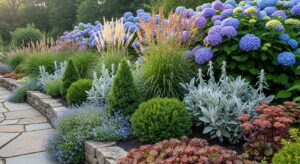
A truly magical border blends multiple plant types.
Imagine tall hydrangeas at the back, ornamental grasses swaying in the middle, and groundcovers spilling over the front edge.
By layering heights and textures, you create depth and interest.
Adding contrasting foliage like silver-leafed lamb’s ear against deep green evergreens enhances the visual magic.
7. Natural Stone and Green Fusion 🪨🌱
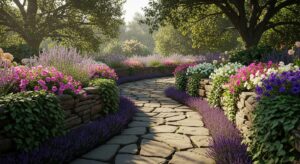
One of the most enchanting design tricks is pairing plants with stone or brickwork. Use lush greenery to soften the hard edges of paths, walls, or patios.
Creeping plants spilling over stone borders create a timeless, romantic effect, while structured hedges framed by brick add sophistication.
This fusion blends man-made and natural elements into one harmonious look.
🌟 Design Tips for Stunning Green Borders
-
Choose the right plants for your climate: Hardy plants ensure your borders last with less effort.
-
Think in layers: Place taller plants at the back, medium ones in the middle, and groundcovers at the front.
-
Plan for all seasons: Mix evergreens with perennials for color, texture, and year-round interest.
-
Balance order and wildness: Neatly clipped hedges bring formality, while trailing vines or wildflowers add whimsy.
-
Add decorative accents: Incorporate lanterns, stone edging, or garden statues for extra charm.
✨ The Magic of Transformation
When designed with intention, green borders don’t just outline spaces they breathe life into them.
They create rhythm, guide the eye, and invite exploration. From the neat geometry of evergreen hedges to the whimsical charm of flowering borders, your garden can become a magical retreat right outside your door.
By embracing Green Border Magic, you can transform your outdoor space into a lush sanctuary that feels alive, welcoming, and timeless. 🌿
🌱 10 FAQs on Green Border Magic
1. What are green borders in a garden?
Green borders are plantings that outline garden beds, pathways, or patios, often using hedges, flowers, herbs, or groundcovers to frame and define spaces.
2. What plants work best for creating green borders?
Popular choices include boxwood, lavender, rosemary, ornamental grasses, creeping thyme, sedum, and hydrangeas. The selection depends on your climate and style.
3. Are green borders only for formal gardens?
Not at all! While clipped hedges give a formal look, loose plantings of flowers, herbs, and grasses create a more natural, cottage-style border.
4. Do green borders require a lot of maintenance?
It depends on the plants. Boxwoods and hedges need regular trimming, while groundcovers and low-maintenance perennials require minimal care.
5. How wide should a garden border be?
Most borders are between 1–3 feet wide, but mixed borders with layers can be much wider for added depth and visual impact.
6. Can I combine flowers, herbs, and shrubs in one border?
Yes! Mixed borders with different plant types add texture, fragrance, and seasonal interest while supporting pollinators.
7. What’s the best way to design green borders for all seasons?
Combine evergreen plants for structure with perennials and bulbs for seasonal color, ensuring year-round beauty.
8. Do borders help with garden maintenance?
Yes, they reduce weeds, prevent soil erosion, and soften hardscape edges like stone paths or patios.
9. How do I choose the right border style for my outdoor space?
Consider your garden’s theme formal hedges suit elegant designs, while wildflowers and grasses complement natural or rustic spaces.
10. Can I add non-plant elements to my green borders?
Absolutely! Incorporating stones, lanterns, or small statues within your borders adds personality and enhances the magical effect.